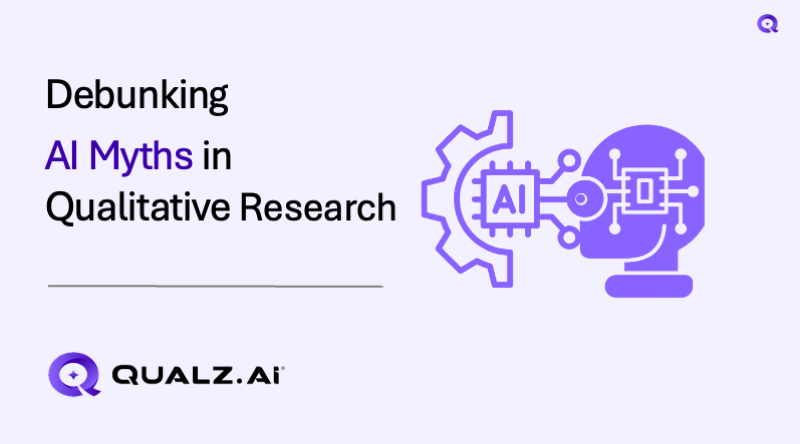In a world increasingly shaped by automation, qualitative researchers find themselves at a crossroads. You’ve built your expertise around depth, empathy, and complexity, so integrating AI can feel counterintuitive. Many researchers fear AI may compromise depth, replace human judgment, or introduce ethical risks.
They have concerns that AI isn’t grounded but rooted in outdated assumptions. It’s time to confront the most common AI myths in qualitative research and clarify how AI can enhance the human-led research process, not compromise it.
Topics Covered
ToggleThis blog debunks the most common AI myths in qualitative research and shows why it’s unsafe but essential for today’s qualitative research landscape.
Myth #1: “AI Removes the Researcher’s Voice”
This myth suggests that AI takes over the analysis process, rendering your insights redundant. Platforms like Qualz.ai’s AI Analysis are designed to amplify your judgment, not override it. Tools such as automated coding and theme discovery surface patterns in large datasets, allowing you to focus more on interpretation and strategy. The researcher stays in control; AI accelerates what used to take weeks.
Myth #2: “AI Interviews Are Impersonal and Rigid”
Many assume that AI-conducted interviews lack emotional nuance. However, AI-Moderated Interviews are surprisingly adaptive. These systems can adjust follow-up questions in real-time, mimicking a natural flow of conversation and reducing interviewer bias. Plus, they remove scheduling friction, making interviews more accessible and scalable without compromising depth.
Myth #3: “Synthetic Participants Aren’t Valid Data Sources”
One of the AI myths stems from a misunderstanding of how AI Participants are constructed. These are not generic bots; they are customizable personas with detailed demographic and psychographic attributes that reflect real-world behavior and logic. They’re invaluable for early-stage testing, hypothesis refinement, and pilot studies, especially when traditional recruitment isn’t feasible.
Myth #4: “AI Struggles with Open-Ended Responses”
This is where AI shines. Advanced platforms now allow researchers to upload and analyze existing qualitative data using AI. Through methods like automated open coding and thematic mapping, researchers get faster, more scalable access to insights buried in free-text responses.
Rather than replacing human nuance, AI helps you scale it.
Myth #5: “AI Compromises Research Ethics and Privacy”
Concerns about data misuse are valid, but they don’t reflect the reality of modern platforms. Tools like Qualz.ai follow IRB-aligned protocols. Its ethical research standards are not just safeguards; they’re core design features.
Researchers can confidently protect participant privacy while streamlining workflows.
From Resistance to Readiness: Reframing the Role of AI
When you move past these AI myths, a clearer picture emerges: AI doesn’t compete with qualitative research; it empowers it. It removes grunt work, reduces bias, and opens new opportunities for scale and rigor.
